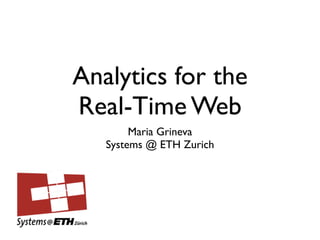This document discusses analytics for the real-time web. It describes how real-time web, enabled by mobile devices and social sharing, requires real-time incremental processing instead of batch processing. The author's system, Triggy, is presented as a solution. Triggy extends the Cassandra distributed key-value store with push-style processing and synchronization to incrementally update aggregate results. Experiments show Triggy can handle high throughput workloads like tweet counting. Similar systems like Yahoo! S4 and Google Percolator are also discussed. Potential applications mentioned include social media optimization, real-time news recommendations, advertising, and game analytics.




















